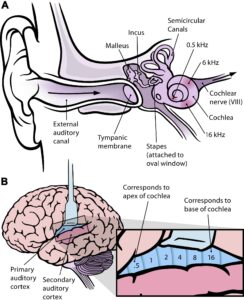Music is omnipresent. From the title song of your favorite television show to an unlimited flow of TikTok dances to the songs of birds outside your window, music is infused into our everyday lives.
Neuromusicology, the study of music from the neuroscience perspective, investigates the behavior related to music composition, listening, and psychological connections. Music has pitch, tone, melody, and rhythm, which are each processed by the brain in unique ways. For example, when music is played, the cells in the ear communicate with the primary auditory cortex inside the brain to process the pitch and tone, whereas melody is processed by the secondary auditory cortex. These regions are close in proximity (Figure 1B), but have different functions for music listening. The primary auditory cortex is the first brain region to process sound from the cochlea, a spiral cavity in the inner ear (Figure 1A). The cochlea processes various frequencies of sound waves from the base (high frequency) to the apex (low frequency). Sound frequencies are then transmitted through cells from the cochlea to the coordinating region on the primary auditory cortex (Figure 1B). The primary auditory cortex then sends signals to the secondary auditory cortex to process melody. Though distinct, these regions of the brain act together to create a cohesive flow of pitch, tone, melody, and rhythm for an enjoyable listening experience.
Figure 1. (A) The human ear and frequency mapping in the cochlea and (B) primary and secondary auditory cortices. Licensed under the Creative Commons Attribution 2.5 Generic license. (Image source)
In addition to listening, the brain is involved in the creation of music, primarily through auditory-motor interactions. The ability to create and process rhythm requires a complex interplay between the hands or feet and the cerebellum, a region of the brain involved in coordination. For example, when the left and right hands perform specific movements on a guitar or piano, signals are sent from the hands, to the cerebellum, and back to the hands. A study investigating brain volume determined that professional musicians have higher gray matter volume in the cerebellum compared to non-musicians. This suggests that musician’s brains likely have more neuronal plasticity in the cerebellum, or the region involved in rhythm.
As humans, we are built to not only listen to and create music, but also respond to music. Music can elicit an array of emotions, feelings, and memories. For example, the brain’s reward system may respond to pleasurable music, whereas the limbic system, which includes the amygdala, may respond to sad music. In reality, music is its own language. It allows us to connect and enhance mood states across the entire spectrum, providing a therapeutic value.
Music is ingrained in our individual lives and in our society. Music has been described as “medicine for the soul” and, thanks to our brain, it continues to enhance our lives with cohesive pitch, tone, melody, and rhythm.
Peer Editor: Colleen Steward
